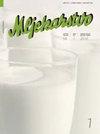使用不同酵母菌生产黄油的香味特征
IF 1.1
4区 农林科学
Q3 AGRICULTURE, DAIRY & ANIMAL SCIENCE
引用次数: 0
摘要
发酵乳制品的香味在很大程度上受起始培养物和用作起始培养物的乳酸菌株的影响。实验黄油样品是在不使用起始培养物、使用商业起始培养物(Lactococcus lactis subsp.lactis、Lactococcus lactis subsp.cremoris、Lactococcus lactis subsp.lactis biovar.diacetylactis、Leuconostoc mesenteroides)、使用混合菌(Lactococcus lactis subsp.lactis EM1、Lactococcus lactis subsp.diacetylactis G49、Leuconostoc mesenteroides B3),以及添加鼠李糖乳杆菌 B19(L. rhamnosus B19)的混合菌。采用气相色谱-质谱法(GC-MS)对黄油样品的香气特征进行了研究。在黄油样品中总共测定了 92 种成分,包括酸类(12 种)、醇类(20 种)、醛类(9 种)、烷类(6 种)、酯类(8 种)、酮类(19 种)和其他一些芳香化合物(18 种)。含有发酵培养基的样品中可检测到的芳香成分最多,而不含发酵培养基的样品中芳香成分最少。在不含起始培养物的样品中未检测到 2,3-丁二酮(双乙酰)。含有商业发酵培养基的样品中 2-丁酮 3-羟基(乙炔醛)含量最高,而不含发酵培养基的样品中含量最低。本文章由计算机程序翻译,如有差异,请以英文原文为准。
The aroma profile of butter produced using different starter cultures
The aroma of fermented dairy products is greatly influenced by starter cultures and by the lactic acid bacteria strains that are used as starter cultures. Experimental butter samples were produced using no starter culture, by a commercial starter culture (Lactococcus lactis subsp. lactis, Lactococcus lactis subsp. cremoris, Lactococcus lactis subsp. lactis biovar. diacetylactis, Leuconostoc mesenteroides), by a prepared bacteria mix (Lactococcus lactis subsp. lactis EM1, Lactococcus lactis subsp. cremoris EM28, Lactococcus lactis subsp. lactis biovar. diacetylactis G49, Leuconostoc mesenteroides B3), and by a prepared bacteria mix fortified with Lactobacillus rhamnosus B19 (L. rhamnosus B19). The aroma profile of the butter samples was investigated using a gas chromatography mass spectometry method (GC-MS). A total of 92 components were determined in the butter samples, including acids (12), alcohols (20), aldehydes (9), alkanes (6), esters (8), ketones (19) and several other aroma compounds (18). The sample containing the prepared starter culture had the most detectable aroma components, while the lowest number of aromatic components were found in the sample without a starter culture. 2,3-butanedione (diacetyl) was not detected in the sample without a starter culture. 2-Butanone 3-hydroxy- (acetoin) content was the highest in the sample containing the commercial starter culture and the lowest in the sample without a starter culture.
求助全文
通过发布文献求助,成功后即可免费获取论文全文。
去求助
来源期刊

Mljekarstvo
Agricultural and Biological Sciences-Animal Science and Zoology
CiteScore
1.90
自引率
41.70%
发文量
18
审稿时长
12 weeks
期刊介绍:
Mljekarstvo is an open access, peer-reviewed international quarterly scientific journal. The first issue was published in 1951, by the Croatian Dairy Operators'' Association (today: Croatian Dairy Union, publisher). In a paper at a Union conference held 28 October 1951 in Zagreb it was said: "Our desire is that this magazine does not meet the fate of its predecessors, but that it continues to reflect the creative efforts and to provide guidelines for the producers as well as all other operators employed in the dairy industry."
It is our pleasure today to say that wishes of the enthusiasts who attended the conference have come true, and the magazine Mljekarstvo during the last six decades was a reflection of the creative efforts of numerous dairy scientists and experts, and through its texts it served as a guideline in improving production and processing of milk and dairy products. Mljekarstvo has been following all the achievements of the dairy profession in Croatia, and it also gives the short surveys of world achievements. The result of the research of local and foreign scientists and experts always find their place in the magazine Mljekarstvo. It has been edited by our outstanding dairy experts employed at colleges, research institutions and dairy companies.
 求助内容:
求助内容: 应助结果提醒方式:
应助结果提醒方式:


